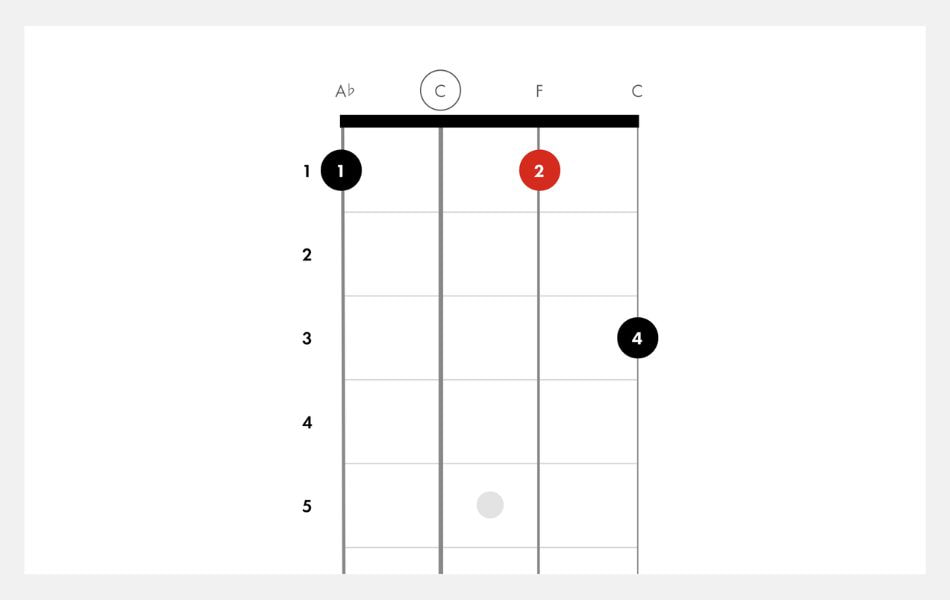Delving into new chords adds depth and richness to your ukulele playing, and mastering the F minor chord is no exception. Whether you’re strumming along to your favorite tunes or creating your own melodies, understanding how to play the F minor chord opens doors to a world of musical expression. Let’s embark on this musical journey together and discover the magic of the F minor chord on the ukulele.
Contents
Understanding the F Minor Ukulele Chord
The F Minor Ukulele Chord is a versatile and melancholic chord that adds a touch of emotion to your playing. To form this chord, place your index finger across the first fret on all strings of the ukulele. Then, place your ring finger on the third fret of the C string. Strumming all strings together will produce the haunting sound of the F Minor Ukulele Chord.
Now that we have covered the basic formation of the ukulele chord, let’s explore its characteristics and applications. The F Minor chord consists of three notes: F, Ab, and C. These notes create a rich and dark tonal quality, perfect for expressing sadness or introspection in your playing. Whether you are strumming or picking, the F Minor chord will bring a unique depth to your compositions.
This chord is commonly used in various musical genres, including jazz, classical, and pop. Artists such as Billie Holiday, Adele, and Radiohead have utilized the F Minor chord to convey intense emotions in their music. Its versatility allows it to fit snugly into different musical contexts, adding a touch of sophistication to any piece.
Fingering the F Minor Ukulele Chord
To understand how to finger the F Minor Ukulele Chord, let’s first familiarize ourselves with the basics. The ukulele is a four-stringed instrument, typically tuned to G-C-E-A. The F Minor chord consists of three notes: F, Ab, and C. To play this chord, you’ll need to press down on specific frets and strings.
- Step 1: Position your first finger on the first fret of the G string (Ab note).
- Step 2: Place your second finger on the first fret of the E string (F note or root note).
- Step 3: The challenging part comes next. Place your third finger on the third fret of the A string (C note).
Now, strum all four strings simultaneously, and you’ll have the F minor or Fm chord. Note the ‘o’ on the third string, indicating that it should be played as an open string (C note).

Strumming Patterns for the F Minor Ukulele Chord
Now that we have the chord position down, let’s explore some strumming patterns that you can use to enhance your playing. Remember to start slow and gradually increase your speed as you become comfortable with each pattern.
1. Downward Strumming
This simple yet effective pattern involves strumming all four strings downward in a steady and consistent motion. Start by strumming from the A string and gradually work your way down. This pattern works well for slower songs or when you want to create a mellow vibe.
2. Upward Strumming
Similar to the downward strumming pattern, this variant involves strumming all four strings upward. Again, start from the A string and strum upwards in a fluid motion. This pattern adds a bit more flair and energy to your playing, perfect for uplifting songs or when you want to inject some liveliness into your performance.
3. Diversify with Mute Strums
To add some rhythmic variations to your playing, incorporate mute strums into your repertoire. By lightly resting your palm against the strings while strumming, you create a percussive effect. Experiment with different combinations of down and up mutes to find your unique rhythm and groove.
4. Syncopated Strumming
For a more advanced strumming pattern, try syncopated strumming. This technique involves emphasizing the off-beats to create a syncopated feel. Alternate between strumming the full chord and muting certain beats to achieve a captivating and intricate rhythm. Syncopated strumming works particularly well in genres like jazz, reggae, or funk.
In conclusion, mastering different strumming patterns for the F minor ukulele chord opens up endless possibilities for your playing. Whether you’re strumming down, up, muting, or syncopating, the F minor chord can truly come alive with these techniques. So, grab your ukulele, try out these patterns, and let your music soar to new heights. Happy strumming!
